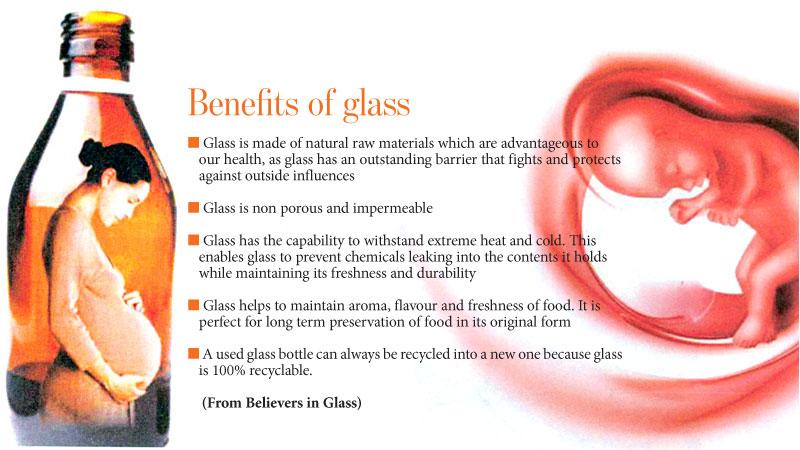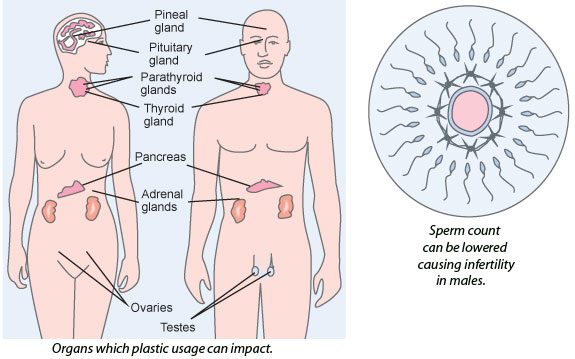
Fears fuelled by recent studies on plastic feeding bottles and their dangerous health impact on infants has resulted in an ongoing battle between plastic and glass manufacturers. Plastic makers claim, the health of infant users will not be seriously jeopordised provided the toxic chemicals used to make plastic bottles are at permissible levels. Glass makers on the other hand insist that research has now proved that even the safest of safe plastic, like bisphenol A (BPA) leaches dangerous chemicals.
Leading the campaign to promote glass bottles as the safer option are Believers in Glass and other activists who recently brought together a panel of local medical personnel to discuss the pros and cons of plastic usage, not just in infant feeding bottles but its use by adults for drinking and bathing.
The speakers included, Dr Suranga Hettipathirana Senior Lecturer and Consultant Gynaecologist and Obstetrician, Prof. Kolitha H. Sellaheva, Prof. of Medicine, Prof. Neville Perera , Prof. of Surgery at Post Graduate Institute of Medicine and Consultant Genito Urinary Surgeon, Dr Lakkumar Fernando, President of the Sri Lanka College of Paediatricians, Dr Waruna Gunathilleka, Head, Department of Toxicology and National Poisons Information Unit, National Hospital and Dr Sanath Mahawiranage, Ex-President Nutrition Society. The consensus of opinion was that plastic was dangerous and due to our average temperature being around 30-35 degrees, the likelihood of harmful chemicals leaching into our food, water and medicines stored in plastic containers was a definite possibility.
Opening the discussions with a shocking statement aimed at taking listeners out of their comfort zones, moderator, Dr Manta Jain from Believers In Glass said, “Plastic bottles are a ticking time bomb waiting to explode and endanger the whole of humanity.”
She said, recent global studies suggest chemicals responsible for various adverse health effects leached from plastic containers, increase by thousandfold when a bottle is exposed to the sun. “Children and infants are especially at high risk, when commercially available plastic resins and products including baby bottles and other products advertised as bisphenol A (BPA) free, release chemicals having Estrogenic Activity (EA),” she noted.
Common concerns
Asked what exactly these adverse impacts had on children , Believers In Glass cited findings from US urologists and scientists in the USA who said. while the effects of plastic toxicity is seen as a major problem in children, the major problem was in utero exposure . “A single dose of these disrupting chemicals can do substantial damage to a developing fetus (baby) causing problems of sexual male organ development. The dangerous aspect is that this impact can be seen in the next generation as it impacts our genes”, a paediatric urologist in the US said, raising fears of a continuing trend affecting future generations.
 The study also unveiled common problems of concern among health officials and scientists. They included:
The study also unveiled common problems of concern among health officials and scientists. They included:
s Learning disabilities in children
s Severe Attention Deficit disorder
s Cognitive and brain development problems
s Deformations of the body (including the limbs)
s Sexual development problems
s Feminising of males or masculine effects on females
Taking the argument to a higher level, Lankan Professor of Surgery and Consultant Geniito-urinary Surgeon Dr Neveill D. Perera disclosed more shocking facts.
According to him, “Globally there has been an increase in male reproductive disorders and a significant rise in the incidence of genital abnormalities in newborn babies, approximately, a threefold increase in the last 40 years.
Many investigators link this sudden increase to chemical exposures in the environment which interfere with the sex hormones during development and sex differentiation which happens during 8-12 weeks of fetal development. Exposure to endrocrine disruptor Chemicals (EDC’s) during the first trimester, significantly increases these chances.” He adds, “These EDC’s, such as, phthalates and bisphenol A are widely used in plastic bottles, vinyl floors, food wrappers, medical products and toys”.
Studies
Meanwhile, more studies in the US have offered further insights on the potential harm of plastic. Let me quote one misleading advertisement on plastic products: “Most plastic products are mischaracterized as being EA free if extracted with only one solvent and not exposed to common use stresses.
But, almost all commercially available plastics sampled independent of the type of resin, product or retail source , leached chemicals and had reliably detectable EA, including those advertised as BPA free. In some cases the BPA free products released chemicals that had more EA than did the BPA containing products,” the study states.
Disruptive
The same studies go on to explain how chemicals that mimic or antagonise the actions of naturally occurring estrogens could have a disruptive effect. “Chemicals that mimic or antagonize the actions of naturally occurring estrogens are defined as having estrogenic activity (EA) which is the most common form of endocrine disrupter activity,” the multiple study said.
What are estrogen disruptors? asked a member of the audience.
Explaining that estrogen was a hormone that helps us develop when we are young and eventually reproduce, the panelists said that estrogen disruptors mimic and interfere with the action or estrogen. “These leached chemicals have been widely detected in blood, urine, amniotic fluid and breast milk, and have been found in nearly all adults and children who have been tested,” they said.
Responding to a question on the health impacts arising from estrogen disruptors activity, the ‘Believers In Glass’ moderator drew attention to the observations of some of the scientists who had done a study on this issue: “We are concerned about its effects on fetuses, infants and children at current exposure levels, and whether it can affect the prostrate, brain, testicles, breasts and behaviour. Studies suggest that the more a baby is exposed to estrogen while in the womb, the greater the risk of breast, testicular and prostrate cancer”.
Prof. of Medicine and Consultant Physician, Dr Kolith Sellahewa highlighting some little known facts on the potential harm plastics had on women’s reproductive systems said, “Women in the reproductive group and children consuming dangerous chemicals in plastics, could have impaired immune development, loss of pregnancy, preterm birth, low birth weight and congenital defects in the child, which could manifest in later life. Most serious proven impact is increased risk of breast caner cells and a rise in hormone dependent cancers like prostrate and breast cancer cells and cancers like prostrate and breast cancer”.
Senior Lecturer and Consultant Gynaecologist and Obstetrician, Dr Suranga Hettipathirana, commenting on the impact of long term use of plastic bottles on the reproductive system in a hard-hitting statement said, “It is one of the root causes of infertility. PET bottles may have long term medical consequences on women, especially, during growing up years and pregnancy. “The release of Bisphenol A (BPA) and additives like diethylhexyl phthalate , can blend with the contents of the bottle and lead to health issues, such as, impaired immune development, increased miscarriage rate and pre-term birth. BPA acts as false oestrogen and can cause chromosomal abnormalities, birth defects and development disabilities. Its exposure is also linked to hyperactivity disorders and aggression in young girls,” he said.
Impact of toxins on genitals in babies
Closer home, a medical study conducted in the Navi Mumbai Hospital, India and presented at the 24th European Society for Paediatritricc Urology in Genoa Italy, in 2013 has also underlined the impact of plastics on reproductive system of, especially, male children. It showed a growing incidence of genital abnormality among boys, because of the increasing exposure to endrocrine disruptor chemicals. Known as phthalates and bisphenol A, these chemicals are used in plastic bottles, food wraps, cosmetics and toys etc. Pointing to an alarming increase of almost 20 percent in the incidence of undescended testicles, and around 5% of full term unborn babies having the same problem, they said in 70 % of cases testes descend with birth. “But what is worrying is that 30% will need surgical correction. An extrapolation of our results suggests that about 700,000 babies would be born in India with undescended testes. Even if there was natural correction in 70% of these children by 6 months of age, there would be 23 lakhs babies every year who will need surgery in India.” It warned, “ If this condition is not treated, it could lead to infertility problems and cancer formation,” they said.
Solution
So, was there a solution to this toxic problem?
“Yes,” says, Toxicology and National Poisons Information Unit Head, Dr Waruna Gunathillaka. He says, “Plastics and their additives aren’t just around us but inside everyone one of us, present in our blood and urine in measurable amounts, ingested with the food we eat, the water we drink. So choose glass instead of plastic. There is no such thing as ’safe plastic’. Research has proved that even the safest of plastics like BPA leaches harmful chemicals. The risks are higher in tropical countries like ours where temperatures are higher than in other countries,” he noted. He appealed for more political commitment and priority to be given to discussing and highlighting the dangers of plastic use and finding ways of reducing the plastic menace in the country by proper garbage cleaning and education of the public and schoolchildren on disposing plastics, like, yoghurt cups, lunch sheets and styro foam lunch boxes, safely.
Dr A.A. Keerthi, from the Institute of Chemistry, echoing these sentiments said, “A study in our country showed that the levels of harmful toxic heavy metals were significantly higher that that of permissible levels. At those levels we are definitely consuming nothing less than poison. This problem is compounded as we do not have a proper cold chain and storage across the country”.
Reiterating his sentiments, the consensus of opinion was that proper storage, constant monitoring of manufacture and distribution and quality evaluation of plastic containers for food and water was a must until the world is able to eradicate the plastic menace.
What do our readers say?
Write to: [email protected]
